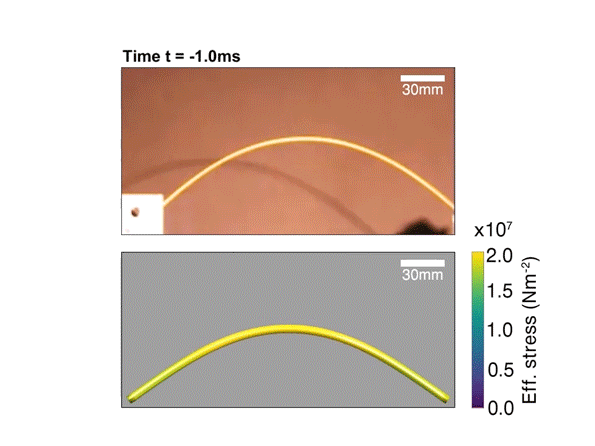
Even thirty years after his death, Richard Feynman remains one of the most beloved minds in physics in part because of how much attention he paid to things other than physics: drawing and painting, cracking safes, playing the bongos, breaking spaghetti. But a physics enthusiast might object, and reasonably so, that all those activities actually have a great deal to do with physics, given the physical phenomena they all demonstrate and on which they all depend. In recent years, considerable scientific attention has even gone toward spaghetti-breaking, inspiring as it did Feynman — and computer scientist Danny Hillis, who happened to be in the kitchen with him — to pose a long-unanswerable question: How come it always breaks into a million pieces when you snap it?
Maybe spaghetti doesn’t always break into a million pieces, exactly, but it never breaks in two. Discovering the secret to a clean two-part break did require a million of something: a million frames per second, specifically, shot by a camera aimed at a purpose-built spaghetti-breaking device. The results of the research, a project of students Ronald Heisser and Vishal Patil during their time at MIT, came out in a paper co-authored by MIT’s Norbert Stoop and Université Aix Marseille’s Emmanuel Villermaux, just published in the Proceedings of the National Academy of Sciences. The team found, writes MIT News’ Jennifer Chu, “that if a stick [of spaghetti] is twisted past a certain critical degree, then slowly bent in half, it will, against all odds, break in two.”
As for why spaghetti breaks into so many pieces without the twist, a question taken on by the Smarter Every Day video just above, French scientists Basile Audoly and Sebastien Neukirch won the Ig Nobel Prize by figuring that out in 2005: “When a stick is bent evenly from both ends, it will break near the center, where it is most curved. This initial break triggers a ‘snap-back’ effect and a bending wave, or vibration, that further fractures the stick.” If you twist the stick first, “the snap-back, in which the stick will spring back in the opposite direction from which it was bent, is weakened in the presence of twist. And, the twist-back, where the stick will essentially unwind to its original straightened configuration, releases energy from the rod, preventing additional fractures.”
So now we know. But the fruits of what might strike some as an obsessive and pointless quest could well further the science of fracturing, which Patil describes to the Washington Post as an outwardly “chaotic and random” process. This research could lead, as Chu writes, to a better “understanding of crack formation and how to control fractures in other rod-like materials such as multifiber structures, engineered nanotubes, or even microtubules in cells.” That’s all a long way from the kitchen, certainly, but even the most revolutionary advancements of knowledge grow out of simple curiosity, an impulse felt even in the most mundane or frivolous situations. Richard Feynman understood that better than most, hence subsequent generations of scientists’ desire to pick up whatever piqued his interest — even broken bits of Barilla No. 5.
Related Content:
The Drawings & Paintings of Richard Feynman: Art Expresses a Dramatic “Feeling of Awe”
Learn How Richard Feynman Cracked the Safes with Atomic Secrets at Los Alamos
Richard Feynman on the Bongos
What Ignited Richard Feynman’s Love of Science Revealed in an Animated Video
A Free Course from MIT Teaches You How to Speak Italian & Cook Italian Food All at Once
Based in Seoul, Colin Marshall writes and broadcasts on cities and culture. His projects include the book The Stateless City: a Walk through 21st-Century Los Angeles and the video series The City in Cinema. Follow him on Twitter at @colinmarshall or on Facebook.


If spaghetti was ment to be short the producers of spaghetti would have made it short.
Don’t ever break the spaghetti!!! Repeat: Don’t break the spaghetti!!!
Yes but would that happen in space. Can we have broken spaghetti powered spacecrat
That never happened to me